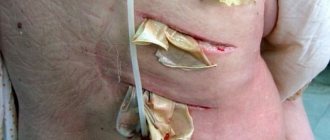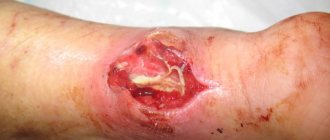Maxillofacial phlegmon: causes and dangers
The vast majority of phlegmons (more than 90%) are odontogenic in nature, that is, they arise due to a tooth that is not treated in time, destroyed by caries or periodontitis. The causative agents of inflammation - staphylococci, streptococci, anaerobic and putrefactive microorganisms - penetrate from the affected tooth root into the tissues of the perimaxillary region due to the peculiarities of the outflow of lymph and venous blood. Another difference between phlegmon and an abscess is that it develops against the background of a significant decrease in immunity, while an abscess can form in a patient with normal protective reactions of the body.
Cellulitis of the maxillofacial area is a dangerous condition that requires serious surgical intervention. The severity of the patient’s condition is determined by the degree of neglect of the process and general intoxication of the body. In addition, nerve endings are concentrated in the jaw area, so a diffuse purulent inflammatory process brings unbearable pain and physical suffering to a person. Vital functions are impaired - swallowing, chewing, speaking, breathing. And a large number of venous plexuses favors the rapid spread of the process and its transition to vital organs and systems. The most severe complications of this disease:
- phlebitis;
- thrombophlebitis;
- mediastinitis,
- abscesses of internal organs;
- meningitis;
- meningoencephalitis;
- sepsis.
Cellulitis is especially severe in children or if it is caused by anaerobic microorganisms.
Causes of orbital phlegmon
The development of orbital phlegmon is usually caused by purulent diseases of the eyes, paranasal sinuses, skin, dentofacial system, injuries of the facial skeleton, as well as general infections.
Almost 70% of cases of phlegmon are a complication of sinusitis, especially ethmoiditis. Purulent inflammation of the orbital tissue, in addition, can be provoked by the penetration of infection from nearby foci of inflammation: diseased teeth and jaws (osteomyelitis of the upper jaw, periodontal abscess), facial skin (furunculosis, erysipelas), eyes (styre, dacryocystitis, phlegmon of the eyelid, infected injuries orbits complicated by foreign bodies of the eye). Less commonly, the cause of the disease is purulent metastasis during sepsis, which is complicated by common infections (scarlet fever, influenza, typhoid).
Phlegmon of the orbit, like other phlegmons, is especially often caused by Staphylococcus aureus and white, hemolytic and viridans streptococcus, less often - pneumbacillus, diplococcus, and Escherichia coli. Pathogens penetrate to the periorbital tissue through the facial veins or orbital veins that do not have valves. In this case, small pustules first form, which then merge into abscesses.
Our team of doctors
Maxillofacial surgeon, Implantologist
Bocharov Maxim Viktorovich
Experience: 11 years
Dental surgeon, Implantologist
Chernov Dmitry Anatolievich
Experience: 29 years
Orthopedist, Neuromuscular dentist
Stepanov Andrey Vasilievich
Experience: 22 years
Endodontist, Therapist
Skalet Yana Alexandrovna
Experience: 22 years
Orthopedic dentist
Tsoi Sergey Konstantinovich
Experience: 19 years
Dentist-orthodontist
Enikeeva Anna Stanislavovna
Experience: 3 years
Treatment of orbital phlegmon
This disease is an indication for emergency hospitalization of the patient and immediate initiation of therapy. At the same time, loading doses of broad-spectrum antibacterial drugs are prescribed, plus symptomatic agents and detoxification drugs. Along with parenteral administration of antimicrobial drugs, retrobulbar and subconjunctival injections are prescribed.
At the same time, ethmoidotomy, maxillary sinusectomy with trepanation of the orbital wall, puncture with drainage of the paranasal sinus, washing it and administering drugs are performed. Identification of areas of fluctuation makes it necessary to perform an orbitotomy with drainage of the wound canal with an antibiotic. As treatment continues, the incisional cavity is washed with antibacterial agents, taking into account the sensitivity of the bacterial flora.
Additionally, for phlegmon, instillation of antibacterial drops is prescribed, as well as instillation of fortified solutions conjunctivally. If opening of the eyelids is possible, application of ointments inside is recommended. Drug therapy is complemented by physical therapy - UHF, ultraviolet radiation, which is prescribed a little later.
Symptoms
Phlegmon of the perimaxillary region, unlike an abscess, develops rapidly and is characterized by severe intoxication. Its main clinical manifestations:
- infiltration on the affected area of the face or neck;
- hyperemia, swelling, soreness of the skin at the site of inflammation;
- high body temperature;
- rapid pulse;
- severe pain when chewing, swallowing, talking;
- spasm of the muscles responsible for opening and closing the mouth (trismus);
- increased salivation;
- weakness;
- chills;
- pale skin;
- loss of appetite;
- sleep disorders;
- enlargement of regional lymph nodes;
- facial asymmetry.
Periandibular phlegmon, photos of which can frighten impressionable people, is always accompanied by an increased number of leukocytes and neutrophils in the blood, a shift in the leukocyte formula to the left and an increased ESR value. The diagnostic sign of phlegmon in the blood serum is C-reactive protein. Protein and white blood cells also appear in the urine.
Symptoms of orbital phlegmon
The purulent process with phlegmon of the orbit, as a rule, is unilateral and is accompanied by rapid development (from several hours to several days). It is characterized by throbbing pain in the eyelids and orbit, which intensifies with palpation and movements of the eyeball. The eyelids are sharply swollen, with a red-violet tint, tense, and open with effort. As inflammation increases, chemosis occurs - pinching of the conjunctiva of the palpebral fissure, diplopia, exophthalmos, displacement of the eyeball, its immobility develops, and vision is significantly reduced. The patient's general condition deteriorates sharply: malaise increases, headache, fever and nausea occur.
When the inflammation process passes to the optic nerve, neuritis and thrombotic blockage of the retinal veins develop, and neuroparalytic keratitis begins, accompanied by the formation of a purulent ulcer on the cornea. When the choroid and other membranes of the eye are involved in the process, choroiditis or panophthalmitis occurs, which results in eye atrophy.
Critical complications of cellulitis include: brain abscess, venous sinus thrombosis, meningitis, sepsis. A relatively favorable outcome of the disease can be considered the spontaneous release of pus through the conjunctiva or skin of the eyelid.
Treatment
Despite the severity of the disease, in general, with timely treatment, perimandibular phlegmon has a favorable prognosis. Treatment is carried out only in a hospital setting, but at the initial stage everything is often limited to the use of conservative methods - antibiotic therapy, the prescription of restoratives, vitamins, and a special diet. But if the process has already started and the spread of infection is observed, complex surgical treatment is indicated, which includes the following points:
- opening the inflammation site under general anesthesia;
- cleansing the wound from pus;
- installation of drains for drainage of wound contents;
- daily treatment with bactericidal solutions;
- powerful antibiotic therapy - often a complex of several drugs is prescribed;
- detoxification of the body;
- use of antipyretic and painkillers;
- prescription of immunomodulating, restorative agents, vitamins;
- physiotherapy – ultraviolet irradiation, UHF, magnetic therapy, etc.
If treatment is successful and there are no complications, the patient’s recovery occurs on average in 14-21 days.
Diagnosis and treatment
Diagnosis of orbital phlegmon should be carried out immediately. This can be done by an ophthalmologist, as well as a dentist and otolaryngologist (ENT). To make a diagnosis, it is necessary to collect an anamnesis, as well as perform instrumental diagnostics - ultrasound and x-ray of the orbit, ultrasound and x-ray of the paranasal sinus, as well as procedures such as CT, biomicroscopy, ophthalmoscopy, etc.
Treatment of orbital phlegmon involves immediate hospitalization. After this, antibacterial and symptomatic therapy is prescribed. Injections are also used: subconjunctival and retrobulbar.
An additional treatment measure may be the prescription of instillations of antimicrobial and vitamin preparations, application of ointment (if the eyelid can be opened).
If active treatment measures have been taken from the very beginning, the prognosis is quite favorable. However, there is a small risk of developing limited eye movement in the future. If the development of a purulent infection is not stopped in time, complications are possible, including generalized sepsis with a fatal outcome.
Causes
The main causes that lead to this disease are streptococci, dental spirochetes, staphylococci, and other anaerobic microorganisms. Due to the characteristics of lymph flow and outflow of venous blood in the maxillofacial area, the infection can penetrate quite deeply. Allergic predisposition, as well as changes in the nonspecific reactivity of the human body, significantly increase the percentage of the likelihood of developing perimandibular phlegmon.
When the infection penetrates through defects in the hard and soft tissues of the tooth and marginal periodontium into the soft tissues, odontogenic phlegmon occurs. Osteogenic (osteophlegmons) develop as a result of odontogenic osteomyelitis, which significantly complicates the course of the disease. Infection can get into the perimaxillary area in several ways:
- through damage to the skin of the face;
- through pustular diseases (furunculosis, sialadenitis, ulcerative stomatitis).
A new method of surgical treatment of phlegmons of the pterygopalatine and infratemporal fossae
A.A. Chuchunov, A.A. Levenets, A.G. Simonov, A.I. Matveev, A.D. Karger, B.V. Igumnov, N.S. Stefarova, S.V. Krikun, P.N. Nikolaev, O.V. Bobkova
State Educational Institution of Higher Professional Education “Krasnoyarsk State Medical University of the Ministry of Health and Social Development of the Russian Federation named after.
V.F. Voino-Yasenetsky" Department of Surgical Dentistry and Maxillofacial Surgery, Department of Maxillofacial Surgery of KKB, Department of Surgical Dentistry of City Clinical Hospital No. 6 It is known that there is a method of surgical treatment in which an incision is made in the mucous membrane of the transitional fold of the upper jaw in the projection from the third upper molar to the zygomaticalveolar ridge, the tissues behind the tubercle of the upper jaw are stratified, followed by revision and drainage of the pterygopalatine and infratemporal fossa[1].
However, the disadvantage of this known method is the high risk of further spread of the purulent-inflammatory process into the underlying buccal tissue space.
Goal of the work:
to develop a new method of surgical treatment of phlegmon of the pterygopalatine, infratemporal fossa and conduct its clinical testing.
We propose surgical treatment of phlegmons of the pterygopalatine and infratemporal fossae as follows: after treating the surgical field twice with antiseptic solutions, local conduction and infiltration anesthesia, we make two incisions of the mucous membrane: one along the transitional fold of the upper jaw in the projection from the third upper molar to the zygomatic alveolar ridge length up to 4.0 cm, the other - in the buccal region along the line of closure of the teeth up to 3.0 cm long, in the upper wound we dissect the periosteum to the bone, bluntly exfoliating the tissue behind the tubercle of the upper jaw we pass into the pterygopalatine, infratemporal fossa, and in the lower wound exfoliating the fiber buccal area up, back and inward we pass to the tubercle of the upper jaw, pterygopalatine, infratemporal fossa, we evacuate purulent discharge from the pterygopalatine, infratemporal fossa, we wash the wound abundantly with antiseptic solutions, drain it with glove drainage (certificate for rationalization proposal No. 2459 dated 05.05.08) .
The results of treating 15 patients with a diagnosis of phlegmon of the pterygopalatine, infratemporal fossa using the proposed method showed that in the postoperative period all patients had swelling of the soft tissues of the buccal area without signs of abscess formation. In the oral cavity, there was a good outflow of purulent exudate from the wounds, which contributed to the rapid cleansing of wounds and a decrease in inflammatory edema and infiltration. As a result, drainage of wounds in the oral cavity was stopped 5-6 days after the opening of the phlegmon.
All patients had positive treatment results, and the hospitalization period was mainly 8-9 days. Subsequently, the patients were discharged for outpatient follow-up treatment by a dental surgeon at their place of residence.
In 20 patients in the control group with phlegmons of the pterygopalatine and infratemporal fossa, surgical treatment was performed according to the generally accepted method. In the postoperative period, this group of patients had more pronounced postoperative swelling of the soft tissues of the buccal and temporal areas. The wound was cleaned more slowly, drainage continued for 8-9 days. In addition, in 5 patients in the control group, the purulent process further spread into the buccal tissue space of the face, which required repeated emergency surgery. The length of hospitalization of patients in the control group ranged from 10 to 12 days.
The advantages of the proposed method are a good outflow of purulent exudate from the pterygopalatine and infratemporal fossae, while reducing the risk of further spread of the purulent-infectious process into the buccal tissue space, which allows for complete rehabilitation of patients at an earlier date.
Bibliography:
1. Robustova T.G. “Surgical dentistry” M. 2003. -504 p.
What causes phlegmon, reasons
The reason for the development of phlegmon is the penetration, active development and spread of infection. As a result, a purulent melting of tissues (fat, muscle, etc.) is formed with damage to nearby organs (vessel walls, intestines, kidneys, etc.). Cellulitis is usually caused by bacteria: more often aerobic, such as streptococci, Staphylococcus aureus, etc., less often by anaerobes (forming spores).
Other factors that influence the development of phlegmon:
- the presence of chronic intoxication due to chronic inflammation, poisoning, chemotherapy, radiation sickness,
- extensive severe injuries,
- patient's immune status,
- virulence of bacteria (ability to cause disease).
Bacteria can enter through a scratch, insect bite, or injury to form a cellulitis just under the skin. They can also move with the blood flow from an inflamed organ (abscess of the kidney, lung, liver, appendiceal abscess, perirectal abscess, etc.).
The bacteria can also attach to the wall of an internal organ, such as the stomach wall or appendix, and form a cellulitis.
People with weakened immune systems may be especially vulnerable to cellulitis formation.
Symptoms and manifestations of phlegmon
Vary depending on the location and severity of the infection. The main symptoms are redness of the skin and swelling at the site of inflammation.
Soft tissue phlegmon against the background of a progressive abscess
The affected part of the body is sensitive to touch and hurts. Fever is later added to this symptom. Swollen associated lymph nodes may occur.
Manifestations of skin phlegmon
- skin redness
- inflammation
- pale swelling of tissues
- swollen lymph nodes
- elevated local temperature
- fatigue
- fever
- headache
Internal organs
Cellulitis can affect any internal organ. Symptoms may vary depending on the organ and the specific bacteria.
- organ dysfunction
- abdominal pain
- fever
- chills
- nausea
- vomit
- diarrhea
- intestinal obstruction
- elevated body temperature
- loss of appetite
- increased thirst
- sweating
- increase in white blood cells (leukocytosis)
Forecast and prevention of the disease
Active treatment undertaken at the initial stages of the disease contributes to a favorable outcome. True, in the long-term period after suffering from orbital phlegmon, a number of complications may arise: limited eye mobility, secondary strabismus, corneal cataract, amblyopia, optic nerve atrophy.
The spread of purulent infection often leads to panophthalmitis, brain abscess, meningitis or thrombosis of the cavernous sinus, as well as generalized sepsis with a fatal outcome.
Prevention of orbital phlegmon consists of timely sanitation of foci of purulent infection of the facial skin, dental system, ENT organs, and eyes. In case of mechanical damage to the eyes or ingestion of foreign bodies, mandatory local antibacterial therapy is necessary to prevent infectious complications.
In the medical department, everyone can undergo examination using the most modern diagnostic equipment, and based on the results, receive advice from a highly qualified specialist. The clinic is open seven days a week and operates daily from 9 a.m. to 9 p.m. Our specialists will help identify the cause of vision loss and provide competent treatment for identified pathologies.
In our clinic, appointments are carried out by the best ophthalmologists with extensive professional experience, the highest qualifications, and a huge amount of knowledge. The clinic examines and treats adults and children over 4 years of age. Our specialists have developed and are actively using effective programs for the prevention and treatment of eye pathologies.
You can find out the cost of a particular procedure or make an appointment at the Moscow Eye Clinic by calling 8 8 (499) 322-36-36 (daily from 9:00 to 21:00) or using the online registration form.
Prevention methods
Cellulitis, like any other disease, can be prevented. It is especially important to follow preventive measures for people who are at risk, with medical diagnoses such as HIV, AIDS, tuberculosis, and diabetes. The main prevention is to prevent skin injuries.
If there are purulent foci in the body, especially in the oral cavity (caries, purulent abscesses on the gums), they must be treated in a timely manner, preventing further development and rupture of purulent foci. If the skin is injured, the cut sites must be immediately treated with antiseptic solutions. You need to be especially careful when preparing fish. A bone injection can lead to the development of erysipelas, which, against the background of a weakened immune system, carries the risk of phlegmon formation.
Considering the rapid development of purulent inflammation, it is necessary to consult a doctor immediately if the skin at the site of the cut becomes red within 24 hours, the area around the wound begins to swell, hurt, a fever appears, and the temperature rises.
Traditional medicine methods can only be used with the permission of the attending physician, with an accurately established diagnosis. As a rule, various decoctions based on medicinal herbs are used in the form of compresses during the rehabilitation period and only as an additional means for faster healing.










